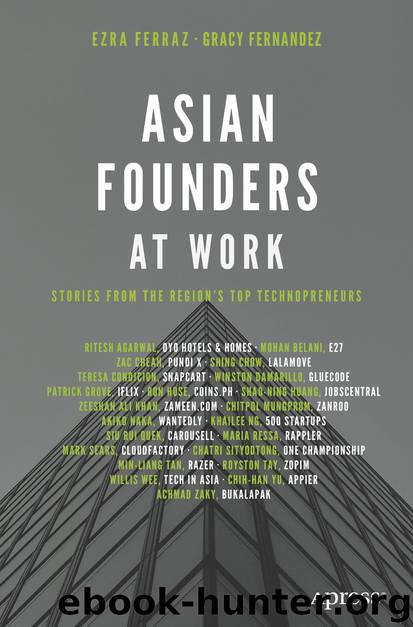Asian Founders at Work by Ezra Ferraz;Gracy Fernandez; & Gracy Fernandez

Author:Ezra Ferraz;Gracy Fernandez; & Gracy Fernandez
Language: eng
Format: epub
ISBN: 9781484251621
Publisher: Springer Nature
© Ezra Ferraz, Gracy Fernandez 2020
E. Ferraz, G. FernandezAsian Founders at Workhttps://doi.org/10.1007/978-1-4842-5162-1_12
12. Mohan Belani: Co-founder and CEO, e27
Ezra Ferraz1 and Gracy Fernandez1
(1)Makati City, Philippines
In 2007, e27 started as a community group among passionate tech and startup enthusiasts who wanted to build the Internet ecosystem in Singapore. e27 was so named as a result of a white paper written by Paul Graham on investing in companies where founders were 27 years old or younger. The “e” stands for entrepreneurs.
In 2012, Mohan Belani and Thaddeus Koh decided to run e27 as a proper media startup serving the regional tech ecosystem. The goal was to provide a platform to empower founders to build and grow their companies, with media as a start. As an online publication, e27 aims to provide this generation of entrepreneurs with the news and knowledge they need to successfully start and scale their business. e27 covers news from Southeast Asia as well as emerging markets across Asia Pacific.
One of e27’s key differentiators is its focus on community. Founders, investors, and other stakeholders can contribute content for editorial review after making a profile on e27. While other publications have guest contributions on the side, e27 may be one of the few that makes growing this community content channel a core focus of their content strategy.
In addition to its f lagship publication, e27 also organizes Echelon Asia Summit, the largest tech and startup conference in the region, gathering over 15,000 attendees from across region. e27 also runs the regional Echelon TOP100 program, gathering 100 of the most promising startups from across APAC. e27 has raised over US $2 million in funding from strategic institutional and angel investors.
Gracy Fernandez: What were the benefits of studying business in the heart of Silicon Valley at Stanford University?
Mohan Belani: Stanford provided a strong theoretical foundation to what was happening in Silicon Valley. The business cases that we studied were from companies that were literally in our backyards. Some of our lecturers were previously entrepreneurs or running companies while teaching, so the knowledge shared came from real-world experiences, and not just theoretical concepts. It was also refreshing to meet students from different backgrounds—tech, business, sciences—coming together to learn about business and building companies. Stanford is truly a melting pot of ideas and innovation.
Fernandez: What was your first exposure to the startup and tech ecosystem while at Stanford University?
Belani: I was studying part-time at Stanford as part of the National University of Singapore Overseas College Program, a one-year program in Silicon Valley, while working full-time at a startup company. The company was called Kriyari and renamed to iStorez a few years later. It was started by a serial entrepreneur, Anand Jagannathan. I was employee number one. I was very lucky to be given the opportunity to work with such an esteemed entrepreneur. It was a phenomenal experience, as I was exposed to many different aspects of a startup, from marketing to attending board meetings, to participating in trade shows. My evenings and weekends were spent attending various tech events and discussing ideas with friends—not to mention some pretty amazing road trips.
Download
This site does not store any files on its server. We only index and link to content provided by other sites. Please contact the content providers to delete copyright contents if any and email us, we'll remove relevant links or contents immediately.
| Private Equity | Valuation |
| Venture Capital |
The Black Swan by Nassim Nicholas Taleb(6758)
Bad Blood by John Carreyrou(6271)
Pioneering Portfolio Management by David F. Swensen(6072)
Millionaire: The Philanderer, Gambler, and Duelist Who Invented Modern Finance by Janet Gleeson(4088)
Skin in the Game by Nassim Nicholas Taleb(3964)
The Money Culture by Michael Lewis(3840)
Bullshit Jobs by David Graeber(3825)
Skin in the Game: Hidden Asymmetries in Daily Life by Nassim Nicholas Taleb(3719)
The Wisdom of Finance by Mihir Desai(3522)
Blockchain Basics by Daniel Drescher(3325)
Liar's Poker by Michael Lewis(3219)
The Intelligent Investor by Benjamin Graham Jason Zweig(2930)
Hands-On Machine Learning for Algorithmic Trading by Stefan Jansen(2925)
Mastering Bitcoin: Programming the Open Blockchain by Andreas M. Antonopoulos(2889)
Fooled by Randomness: The Hidden Role of Chance in Life and in the Markets by Nassim Nicholas Taleb(2855)
Investing For Dummies by Eric Tyson(2789)
The Power of Broke by Daymond John(2768)
Market Wizards by Jack D. Schwager(2538)
Zero Hour by Harry S. Dent Jr. & Andrew Pancholi(2531)
